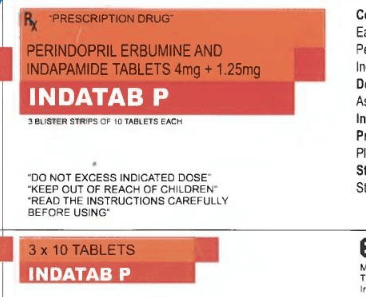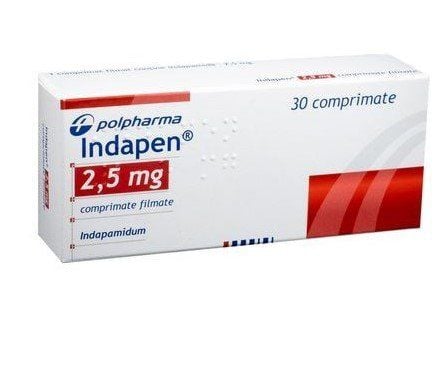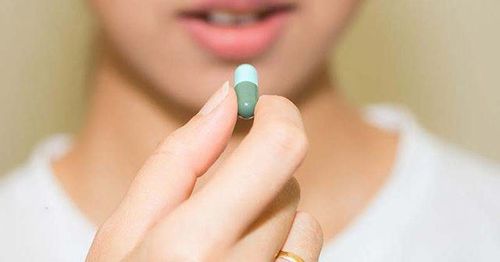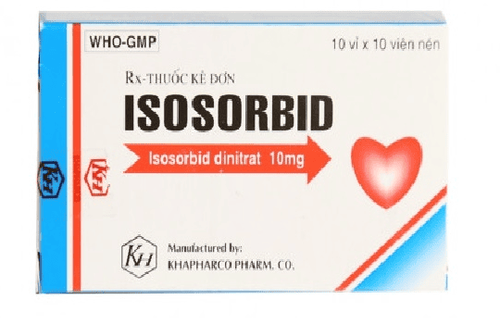This is an automatically translated article.
Pamidstad drug is made in the form of tablets with the main ingredient in each tablet is Indapamide 2.5 mg. So what is Pamidstad and how does it work?
1. Effects of the drug Pamidstad
The main ingredient of the drug Pamidstad is Indapamide, this is a sulfonamide diuretic, containing an indole nucleus, not of the thiazide group. This active ingredient has a diuretic and antihypertensive effect.
2. Indications and contraindications of the drug Pamidstad
Pamidstad drug is indicated in the following cases:
Treatment of essential hypertension. Pamidstad can be used alone or in combination with other antihypertensive agents. Treatment of salt and fluid retention associated with congestive heart failure. In the case of patients with severe, acute left-sided heart failure, stronger diuretics such as bumetanide or furosemide should be used first. The use of Pamidstad is contraindicated in the following cases:
People with hypersensitivity to indapamide, or other sulfonamides or any of the excipients in the formulation of Pamidstad. Patients with severe renal failure. Hepatic encephalopathy or severely impaired liver function. Decreased blood potassium.
3. Precautions when using Pamidstad
Use caution when using Pamidstad in the following cases:
Elderly People who are malnourished and/or treated with many drugs. Cirrhotic patients with edema and ascites Coronary artery disease Patients with heart failure. Diabetic patients Gout Pamidstad contains an active ingredient that can give a positive doping test, so athletes need to be careful when using it. Pamidstad does not affect attention, but in some cases it can cause hypotension, especially when starting treatment with Pamidstad or when other antihypertensive drugs are added. This condition impairs the ability to drive or operate machinery. Pamidstad should be avoided during pregnancy. Pamidstad should not be used during breast-feeding.
4. Dosage and how to use Pamidstad
Pamidstad is to be taken orally, you need to swallow the tablet whole, do not break, chew or crush the tablet.
Dosage of Pamidstad drug should be according to the doctor's prescription, the reference dose in specific cases is as follows:
High blood pressure:
Adults:
Use a dose of 1 tablet/day, taken in the morning. The antihypertensive effect of Pamidstad is only reached after several months of starting treatment. The use of Pamidstad doses > 2.5 mg/day is not recommended, as the antihypertensive effect will be negligible while the diuretic effect is evident. If taking Pamidstad at a dose of 1 tablet / day is not enough to lower your blood pressure, your doctor may prescribe another antihypertensive drug. Drugs used in combination with Pamidstad include angiotensin-converting enzyme (ACE) inhibitors, beta-blockers, methyldopa, clonidine, and other adrenergic blockers. The concomitant use of Pamidstad with diuretics that may cause hypokalemia is not recommended. There was no evidence of re-hypertension upon discontinuation of Pamidstad. Patients with severe kidney and liver damage
In severe renal failure (patients with creatinine clearance < 30ml/min), treatment with Pamidstad is contraindicated. In patients with severe liver damage, treatment with Pamidstad is contraindicated. Elderly
Elderly people use the normal dose of Pamidstad when kidney function is normal or only slightly impaired. Pediatric patients
Pamidstad is not recommended for use in children and adolescents due to a lack of data on safety and efficacy. Treatment of salt and fluid retention associated with congestive heart failure in adults
Use 1 tablet once a day. After 1 week, the dose of Pamidstad can be increased to 2 tablets / time / day if needed.
5. Treatment of overdose and missed dose
Pamidstad drug has no toxicity up to a dose of 40mg, equal to 16 times the therapeutic dose. Signs of acute Pamidstad toxicity are manifested in all water/electrolyte disturbances such as hyponatremia, hypokalemia. Clinically, patients may present with symptoms such as nausea, vomiting, hypotension, dizziness, somnolence, spasms, confusion, polyuria or oliguria, even to the point of anuria due to hypovolemia. blood accumulation.
The initial measures of an overdose of Pamidstad is to quickly remove the drug from the body by gastric lavage and/or activated charcoal. Then restore the patient's water/electrolyte balance to normal.
If you forget a dose of Pamidstad, take it as soon as you remember. However, if it is almost time for your next dose of Pamidstad, skip the missed dose and resume your dosing schedule. Do not use a double dose of Pamidstad to make up for a missed dose.
6. Side effects of the drug Pamidstad
Common side effects of Pamidstad include:
Hypersensitivity reactions Macular rash. Less common side effects of Pamidstad include:
Vomiting. Hemorrhagic rash. Rare side effects of Pamidstad include:
Agranulocytosis Aplastic anemia Hemolytic anemia Leukopenia Decreased thrombocytopenia. Increased blood calcium. Dizziness Fatigue Headache Paresthesia. Arrhythmia Lowers blood pressure. Nausea Constipation Dry mouth. Abnormal liver function Angioedema Urticaria Toxic epidermal necrolysis Stevens - Johnson syndrome. If the patient shows any unusual symptoms while using Pamidstad, they should immediately notify the doctor or go to a medical facility for timely treatment.
7. Interaction of Pamidstad with other drugs
It is not recommended to combine Pamidstad with Lithium.
Caution when using Pamidstad in combination with the following drugs:
Drugs that cause torsades de pointes such as: Class Ia antiarrhythmic drugs (such as quinidine, hydroquinidine, disopyramide). Class III antiarrhythmic drugs (such as sotalol, amiodarone, dofetilide, ibutilide). Some antipsychotics. NSAIDs (systemic routes) include selective COX-2 inhibitors and high-dose salicylic acid (≥ 3g/day). Angiotensin-converting enzyme (ACE) inhibitors. Hypokalemic compounds amphotericin B (IV), gluco - and mineralo - corticosteroids (systemic route), tetracosactide, stimulant laxatives. Baclofen and digitalis preparations. Consider when combining Pamidstad with the following drugs:
Potassium-sparing diuretics (eg amiloride, spironolactone, triamterene). Metformin. Contrast contains iodine. Antidepressants like imipramine. Sedative drugs. Calcium (salts). Ciclosporin Tacrolimus. Corticosteroids, tetracosactide (systemic route). Pamidstad drug is made in the form of tablets with the main ingredient in each tablet is Indapamide 2.5 mg. This is a cardiovascular drug indicated for the treatment of hypertension, congestive heart failure,... To ensure effective treatment and avoid unwanted side effects, patients need to strictly follow the instructions. under the guidance of a specialist doctor or pharmacist.
Follow Vinmec International General Hospital website to get more health, nutrition and beauty information to protect the health of yourself and your loved ones in your family.













